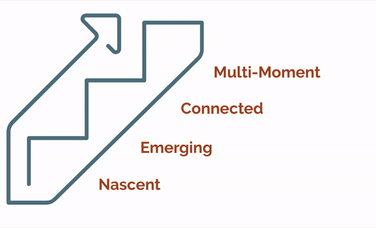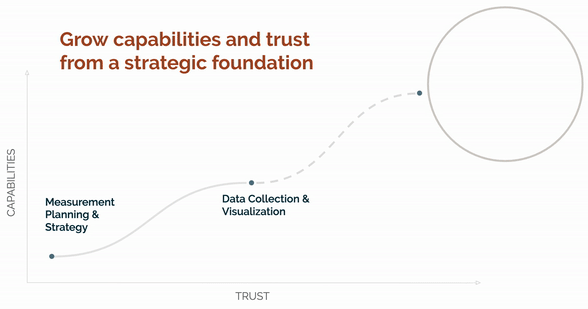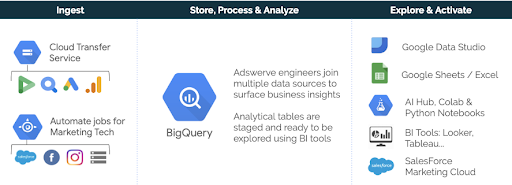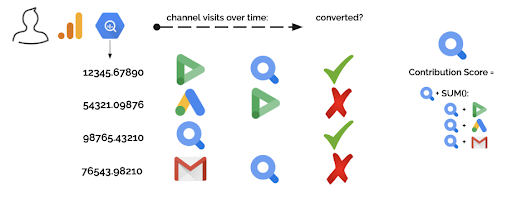
Subscribe to our monthly newsletter to get the latest updates in your inbox
 Developed in partnership with Boston Consulting Group (BCG), Google’s benchmark is a diagnostic tool that informs where your business sits on the path to full data-driven marketing and attribution. Google and BCG identified four stages on the Digital Maturity scale, including:
Developed in partnership with Boston Consulting Group (BCG), Google’s benchmark is a diagnostic tool that informs where your business sits on the path to full data-driven marketing and attribution. Google and BCG identified four stages on the Digital Maturity scale, including:
 Step 1: Building a Solid Foundation
The first step on our Capabilities Framework involves building a strategic foundation through
Measurement Planning and Strategy.
Building this foundation involves:
Step 1: Building a Solid Foundation
The first step on our Capabilities Framework involves building a strategic foundation through
Measurement Planning and Strategy.
Building this foundation involves:
 Throughout this process, we help our clients understand that data collection is informed by strategy (like taking the above strategic steps) and strategy is informed by reality. To help reveal reality, we’ve built tools to drill into our analytics platforms with high-fidelity analysis. For example:
Throughout this process, we help our clients understand that data collection is informed by strategy (like taking the above strategic steps) and strategy is informed by reality. To help reveal reality, we’ve built tools to drill into our analytics platforms with high-fidelity analysis. For example:
 With the Google Cloud Platform in place, we can easily turn on BigQuery (BQ) to build a data-driven attribution model:
With the Google Cloud Platform in place, we can easily turn on BigQuery (BQ) to build a data-driven attribution model:
 Build your own data-driven, probabilistic multi-touch attribution model
using this Python Notebook
as a reference. The notebook transposes
Xuhui Shao’s Simple MTA method
using BQ and the GA export schema, Github code.
Conclusion
This journey may seem lengthy and complex, and you’re right — it is. But research into data-driven marketing maturity by Google and the Boston Consulting Group found that only 2% of businesses use insights and technology to create useful, relevant experiences at multiple moments across the purchase journey.
By building out a strategic foundation and unlocking the power of Google Cloud Platform and BQ, you can set your organization above the rest and drive real, sustainable competitive advantages. If you’re interested in learning more about how we’re helping clients like YETI drive multi-moment marketing optimized toward individual customer outcomes and transactions, please
reach out
! We’d love to help you move along the maturity framework. And don’t forget to check out the Google on-demand webinar for even more insights.
Build your own data-driven, probabilistic multi-touch attribution model
using this Python Notebook
as a reference. The notebook transposes
Xuhui Shao’s Simple MTA method
using BQ and the GA export schema, Github code.
Conclusion
This journey may seem lengthy and complex, and you’re right — it is. But research into data-driven marketing maturity by Google and the Boston Consulting Group found that only 2% of businesses use insights and technology to create useful, relevant experiences at multiple moments across the purchase journey.
By building out a strategic foundation and unlocking the power of Google Cloud Platform and BQ, you can set your organization above the rest and drive real, sustainable competitive advantages. If you’re interested in learning more about how we’re helping clients like YETI drive multi-moment marketing optimized toward individual customer outcomes and transactions, please
reach out
! We’d love to help you move along the maturity framework. And don’t forget to check out the Google on-demand webinar for even more insights.Registration for this webinar is now closed. Check back soon for on-demand access.
Find a time to talk media, measurement or both!
Our media geniuses, analytics savants and industry-leading data scientists have deep expertise and a passion for helping our clients use it effectively. And they'd love to help you achieve your marketing goals.
